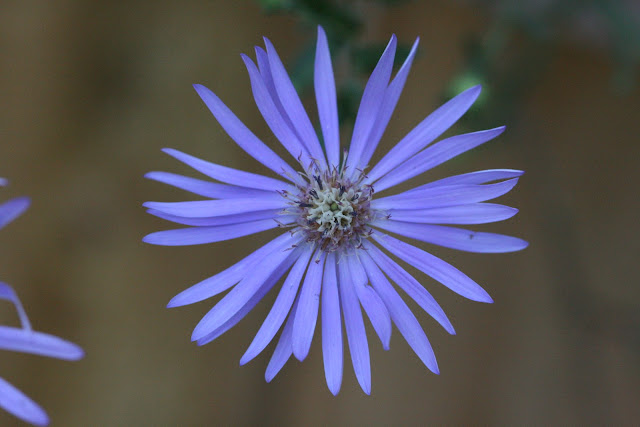Georgia aster (Symphyotrichum georgianum) occurs in only one Florida county along the Georgia border and is a state threatened species in Georgia as well. It is resident to well-drained soils; the edges and openings within deciduous upland forests and in cleared areas such as roadway right-of-ways.
Like other members of this genus (formerly placed in the genus, Aster), it is a deciduous perennial that dies back to the ground each winter and re-emerges again in the spring. Its upward growth is rapid and by early fall it stands 4-5 feet tall. The semi-woody stem is stout and both the stems and leaves are rough hairy. Many side branches are present and blooming occurs on the ends of each in fall; October into November.
Georgia aster is not a particularly beautiful foliage plant. Its large, almost gangly growth form and its rough elliptical leaves are not especially interesting. It makes up for that, however, by its brilliant blue flowers. The ray petals are a rich purple-blue that is matched by no other wildflower; a bit like eastern silver aster, but richer. The disc flowers are white and turn reddish as they age. Each flower head is more than 1 inch across and large numbers are produced at any one time. Aster flowers are of great interest to butterflies and bees, and this species is no exception.
We have not yet tried this species in our Pinellas County landscape, but suspect it will perform much the same as other dry-site asters that we currently grow. Georgia aster suckers as other asters tend to do and eventually produces colonies consisting of many stems. Because of its size, it would have to be planted at the back of a mixed wildflower garden and used partly as a screen. Currently, we have 3 blooming plants in pots at our Hawthorn Hill nursery and we intend to collect seed from them later this winter to experiment more with them. If you are interested in seedlings (and we get some...), please let us know.




Wow! A stunning blue! I found you accidentally while research Florida Liatris species. Great work. Great site.
ReplyDeleteGeorgia Aster can be heavily pruned during the growing season to increase density and the ability of the stems to remain erect. The comments on foliage above are correct, but experience shows the general appearance is improved by periodically cutting it back during the growing season, stopping in September. An added benefit of cutting this plant back is more and tightly spaced flowers. It also appears that cutting the plants back may encourage spreading. The plants are self sterile and do not reliably produce viable seeds which may be a contributor to their decline. This is a very striking plant in bloom, but does not bloom until late fall, usually in November.
ReplyDeleteThanks to "Anonymous" for posting this. As he/she correctly points out, we don't have to go with what's natural in a plant when it becomes part of our garden, and judicious pruning helps a lot of otherwise lanky plants - Vernonias, for example. Since I posted this 2 years ago, I have found Georgia aster to do quite well in our Pinellas landscape. It suckers outward, but close to the main stem - so it forms nice dense clumps over the years. My friend, author, and avid gardener, Rufino Osorio has been growing this in his Broward County landscape with good results as well. Give this species the right conditions and it can be grown statewide. It is also starting to be offered by a number of nursery sources.
ReplyDelete